Want more customers from your Facebook campaigns? Looking for a model for scaling Facebook ads?
In this article, you’ll discover a three-step Facebook ads strategy to scale your business results.
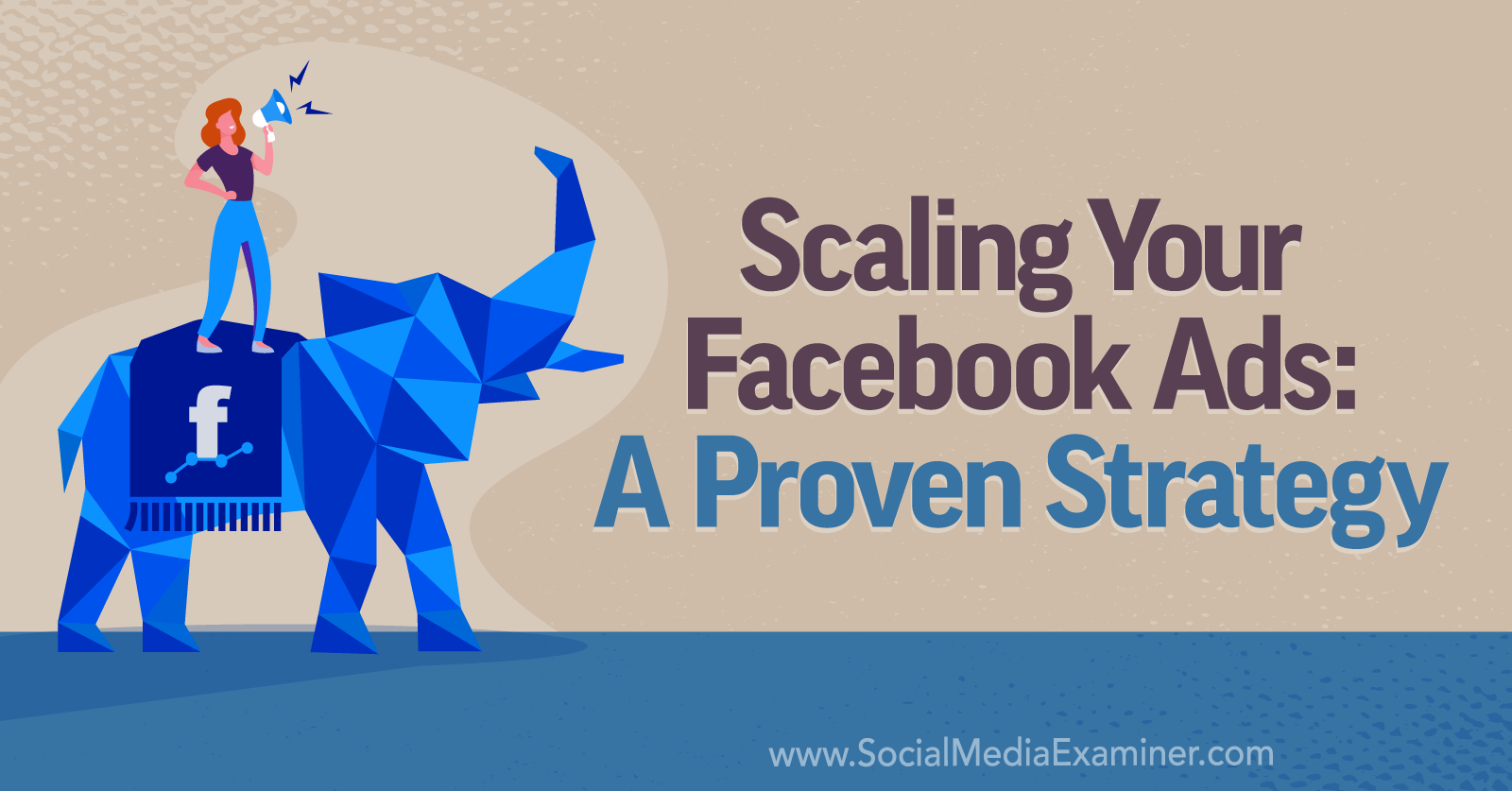
Facebook Ads Are All About Scale
At the end of 2022, Facebook had almost 3 billion monthly active users. That’s more than a third of Planet Earth’s population. And all of those users see Facebook ads.
No other social network has replicated the scale and sophistication of Facebook Ads. YouTube might be similar in size, TikTok might have pioneered vertical video, and Twitter might have political clout… but none of them can match Facebook for its data and ad targeting.
Even if someone launched a new platform today, with all of the ad capabilities and audience size of Facebook, the big blue social network would still win. It has almost 20 years’ worth of user profiles, locations, buying behavior, conversations, and interaction data in the bank.
The Facebook Ads platform gives you the power to grow and monetize in a reliable, affordable, low-effort way. You can make money without breaking your budget, generate a predictable cash flow, and plan for the future. There’s just no better way to scale up your business than through Facebook.
And it all comes down to a single Facebook ad campaign.
The One Campaign Strategy for Scaling Facebook Ads
Here’s a secret: You don’t need lots of different ad campaigns to make an impact on Facebook. You just need one great campaign. That can be the focus of all of your time, effort, and Facebook ad spend.
Think of your Facebook Ads strategy like a machine. Which one is more reliable: the simple, solid machine that does just one thing, or the complex, fragile machine that does 10 different tasks?
The simpler machine will always be more reliable. What’s more, it’s easier to improve. Facebook Ads uses machine learning to get smarter and more effective, and it’s easier for the algorithm to learn what you need when you keep things simple.
In the One Campaign strategy for scaling Facebook ads, you’ll get the Facebook Ads algorithm to do all of the work for you. It can find your audience, test new placements, make the most of your ad budget, learn what works, and build on successes.
The whole strategy takes just three easy steps:
- Use broad targeting.
- Create 3-2-2 content.
- Test ads with the scientific method.
Let’s get into the details of scaling your Facebook ads!
#1: Use Broad Targeting In Facebook Ad Campaigns
For a long time, Facebook ad strategies focused on finding the perfect audience. Marketers built custom audiences, scoured the social network for lookalikes, and developed long lists of interests to define ever-narrower groups of people.
Get World-Class Marketing Training — All Year Long!
Are you facing doubt, uncertainty, or overwhelm? The Social Media Marketing Society can help.
Each month, you’ll receive training from trusted marketing experts, covering everything from AI to organic social marketing. When you join, you’ll also get immediate access to:
- A library of 100+ marketing trainings
- A community of like-minded marketers
- Monthly online community meetups
- Relevant news and trends updates
But things have changed. Now, your best strategy is to target as broad an audience as possible.
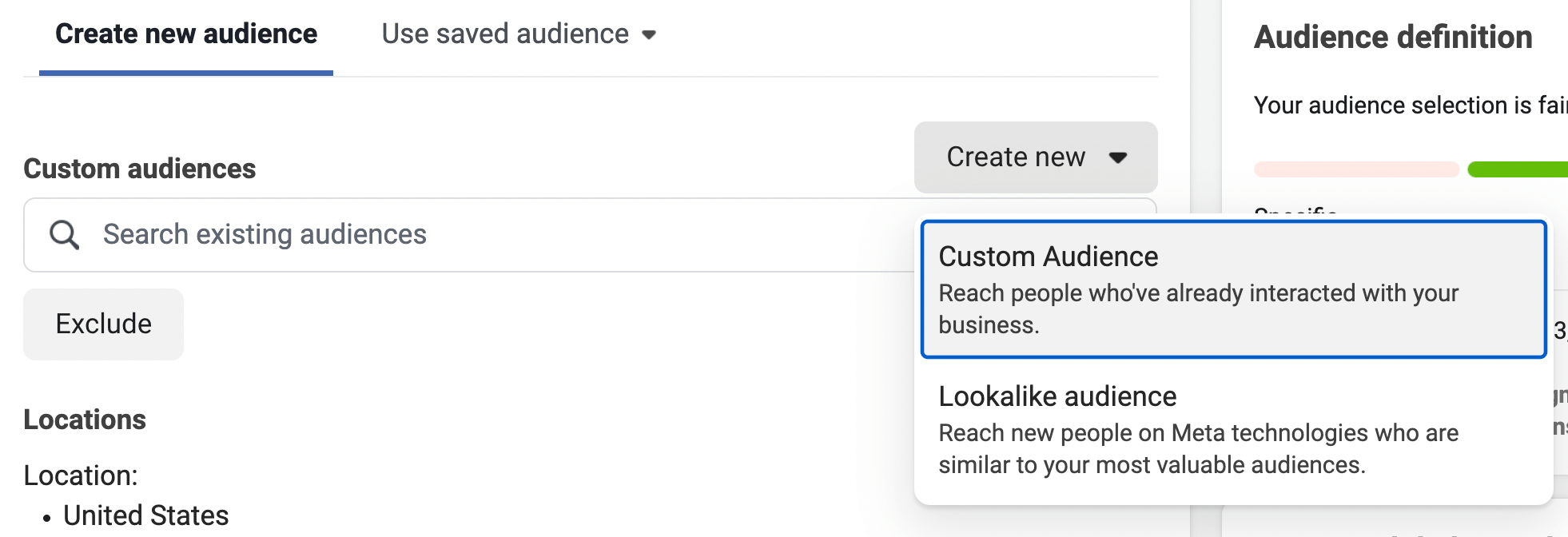
Why You Should Target Broad Audiences
There are three big reasons that narrow targeting doesn’t work for scaling Facebook ads:
- Your information is inaccurate. Old-style Facebook targeting, based on lookalike audiences and interest groups, is less precise than it used to be. Changes to privacy policies and online tracking mean that it’s harder to identify specific audiences on social media.
- Interests aren’t the same as purchase intent. Even where Facebook can sort people into interest groups, those interests don’t necessarily predict a purchase. Users can get added to interest groups by accident; for example, if they post a status about disliking a product and the algorithm reads that as an interest in the relevant keywords.
- You’re doing too much of the work. Old-style targeting may be less effective but Facebook Ads has gotten better at scaling up automatically and testing content in front of new audiences. When you set up a broad audience for your ads, you’re giving the algorithm more opportunity to find potential customers.
It’s also worth thinking about how your cost per 1,000 impressions (CPM) affects the algorithm.
When you target a narrow audience, it will usually cost more to get 1,000 impressions, simply because your audience is smaller. The algorithm picks up on CPM as an important signal about the quality of your content.
A high CPM suggests that your content isn’t connecting with people. Your ads will be shown lower down in the Facebook feed and they’ll cost more.
If you have a lower CPM, it’s the exact opposite. The algorithm decides that people love your content. Ad inventory will cost you less and your content will be shown earlier in the feed.
That’s what happens when you use broad targeting and campaign budget optimization (CBO) for your Facebook Ads. You give the algorithm a chance to find an audience for the content. Then, as your CPM drops, you reap the benefits of cheaper, more favorable ad placements.
What Exactly Is Broad Targeting?
By now, you’re probably wondering what counts as broad targeting. Should you show your ads to literally everyone?
Well, it’s still a good idea to have a few parameters in place. Here’s what you should set up:
- Age
- Gender
- Location
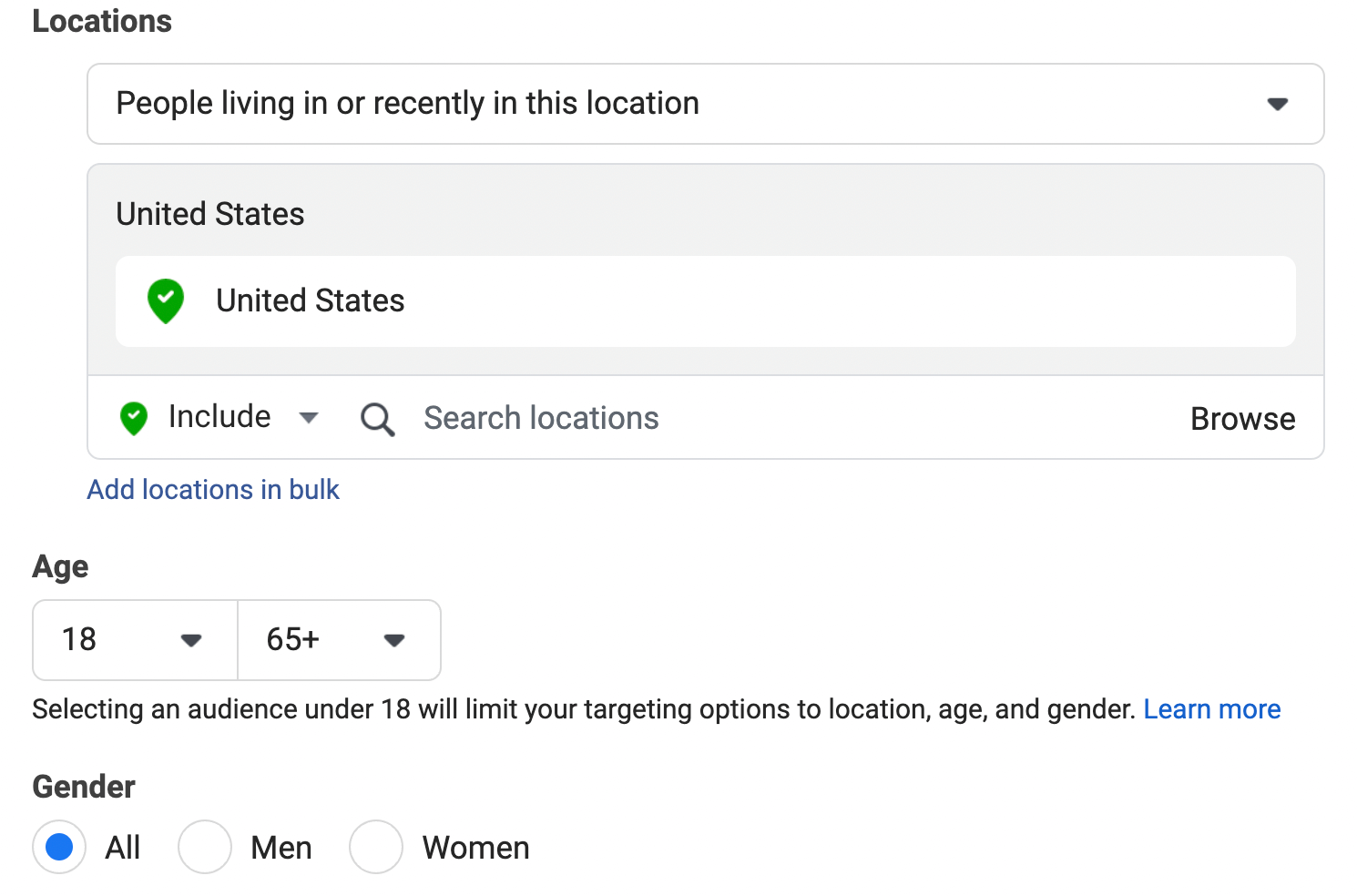
That’s it! Any more specific and you’ll start to limit your potential audience. Remember, we’re focusing on scale and letting the algorithm do its thing. Your content will find and curate its own audience through the algorithm more effectively than you ever could with narrow targeting.
Think of it this way. Let’s say the algorithm shows your ads to a broad audience of 1,000 people—500 of them hate it and 500 of them love it. Those 500 fans will send a clear-enough signal to the algorithm that your content will be a success. Your next 1,000 views will be a better-targeted audience. There’s a positive feedback effect.
With this strategy, your content speaks for itself. But that means you’re going to need really good content.
#2: Create 3-2-2 Facebook Advertising Content
The next step in the One Campaign strategy is to create content that finds the right audience and gets results. Broad targeting will help keep your CPM low. Good content controls your cost per action (CPA).
To do this, you’re going to use the dynamic creative option in Facebook Ads to pass on some of the effort to the Facebook algorithm once again. You’re going to learn the 3-2-2 method for identifying the most effective content.
How to Use Dynamic Creative in Your Campaigns
When you create a new ad set in your Facebook campaign, you can choose to set up dynamic creative.

This is a smart option that Facebook Ads offers to save you time. You can plug in multiple different versions of the creative, ad copy, headlines, descriptions, and calls to action (CTAs). Then the ad algorithm will try out different combinations to see what people respond to best. It will find the most effective ad format, layout, and content to get a response from your target audience.

Discover Proven Marketing Strategies and Tips
Want to go even deeper with your marketing? Check out the Social Media Marketing Podcast! Publishing weekly since 2012, the Social Media Marketing Podcast helps you navigate the constantly changing marketing jungle, with expert interviews from marketing pros.
But don’t let the name fool you. This show is about a lot more than just social media marketing. With over 600 episodes and millions of downloads each year, this show has been a trusted source for marketers for well over a decade.
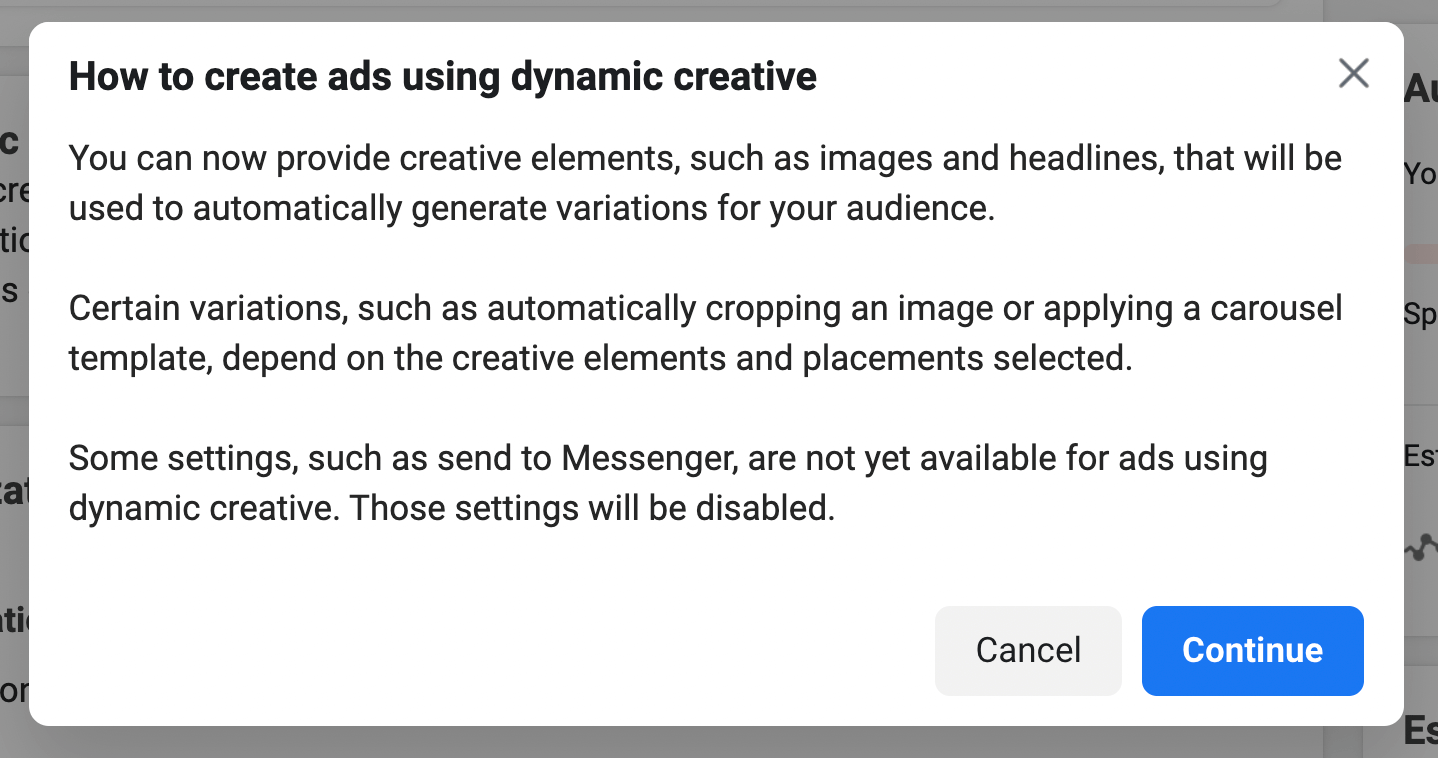
It’s much faster than creating 100 different ad versions by yourself. Instead of splitting up your budget and guessing what might be effective, you can concentrate your spending on a single ad set and let the algorithm do all the legwork.
The 3-2-2 Method
So what should you put into your dynamic creative ad set?
We’re going to keep it simple:
- 3 different versions of ad creative
- 2 different versions of the primary text
- 2 different headlines
With this input, the dynamic creative algorithm will be able to create 12 different versions of your ad using different combinations of the creative, primary text, and headlines.
You might have noticed that we’re not testing any variations on the CTA. That’s because for a lot of Facebook ads, the text of the CTA doesn’t actually make much difference. Users already understand that they can tap on a post for more information. If you work too hard on the CTA, it just becomes a distraction from the rest of your content.
Tips for Good Creative
So far, so scientific. But what about the details of your ad creative and copy? How do you create good content to test in your ads?
Here are a few tips to get you on the right track.
- Aim for the ideal. Start by thinking of your ideal customer or your most effective marketing angle, and then create content to match.
- Take inspiration from other channels. Look at your most effective email campaigns, product descriptions, social media posts, landing pages, and organic content. What has your audience responded to in the past?
- Make either images or videos, not both. You’ll get clearer results and save time if you focus on one media format for each ad set. Don’t mix and match.
- Create content for the placements you want. If you want your ads to appear in the Reels feed, then make vertical videos. If you want to show up on the Facebook home page, then make image carousels. Think about your ideal placements and design for them!
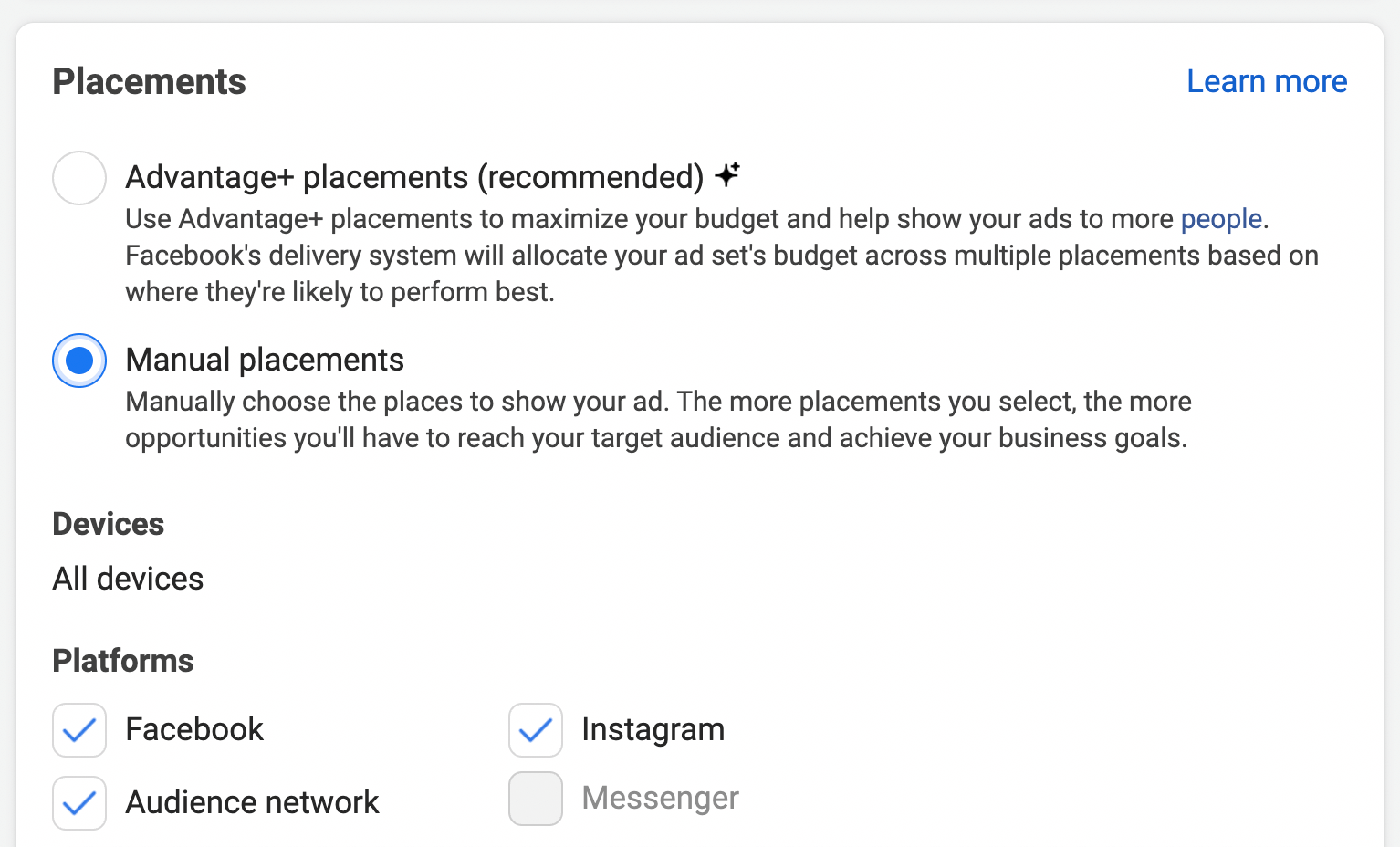
#3: Test Ads Using the Scientific Method
So you’ve set up an ad set with a broad audience, plugged in your 3-2-2 content, and you’re waiting for the dynamic creative to do its work.
What comes next? Testing!
You’re going to test ad sets using the scientific method and then feed the results back into your Facebook Ads strategy for maximum scale and impact.
The Scientific Method for Ads
In case it’s been a while since you took a science class, here’s what the scientific method involves.
You have a “control” ad set, which always stays the same. You have “variable” ad sets, which contain new ideas and creative. You run both the control and the variables at the same time, and then compare the results to see if your new ideas are performing better than the originals.
In the One Campaign strategy, you have one control ad set and two variables. This is to maximize your testing capabilities without getting overwhelmed and losing track of the data.
Your control ad set is full of winners: the posts that performed best in the past. Your variable ad sets contain the dynamic creative tests with 3-2-2 content.
The goal? To create ads that match or even beat the success of the control ad set.
How to Read Your Results
To find the best ads in each set, you’ll need to break things down.
Head over to the analytics for your variable ad sets, go to Delivery, and split them into separate dynamic creative elements. Then you’ll be able to see not only how the ad performed but also which version of it was most successful.
For even more data, you can choose Preview Facebook Post Comments to see which version got the most engagement, described as the Estimated Action Rate.
Next, look at the budget.
- If a version of the ad didn’t get any spend, even with campaign budget optimization, then it was bad. The Facebook algorithm didn’t think it was worth spending your money on.
- If a version got plenty of spend and impressions but no conversions, then your content needs tweaking. You’re reaching people but not the right people. Fix it before it damages your standing with the algorithm.
- If a version got plenty of spend, impressions, and conversions, then you have a new winner. Congratulations!
Chances are, the dynamic creative option will have produced one or two winners, plus some less successful versions. You can discard these posts and just keep the best ones.
What Happens Next?
As soon as you have a winning ad, go back to your control ad set and add that post ID to the set. The new winner will stay in your control ad set, earning conversions and strengthening your status with the algorithm.
Then get straight back to creating new tests.
If you stick to this pace, then you’ll get consistent results that you can have faith in. Any faster and your results would be less useful. Any slower and you’d be missing out on opportunities to scale. The One Campaign strategy for scaling Facebook Ads is the perfect way to keep growing without losing control.
Charley Tichenor is a Facebook ad strategist. He’s creator of the Facebook Ads MBA Program, which teaches entrepreneurs and marketers to optimize and scale their ads. Subscribe to his YouTube channel The Facebook Disrupter or find him on Twitter, TikTok, Instagram, and LinkedIn as @ctthedisruptor.
Other Notes From This Episode
- Connect with Michael Stelzner @Stelzner on Instagram and @Mike_Stelzner on Twitter.
- Watch this interview and other exclusive content from Social Media Examiner on YouTube.
Listen to the Podcast Now
This article is sourced from the Social Media Marketing Podcast, a top marketing podcast. Listen or subscribe below.
Where to subscribe: Apple Podcasts | Spotify | YouTube Music | YouTube | Amazon Music | RSS
✋🏽 If you enjoyed this episode of the Social Media Marketing podcast, please head over to Apple Podcasts, leave a rating, write a review, and subscribe.
Stay Up-to-Date: Get New Marketing Articles Delivered to You!
Don't miss out on upcoming social media marketing insights and strategies! Sign up to receive notifications when we publish new articles on Social Media Examiner. Our expertly crafted content will help you stay ahead of the curve and drive results for your business. Click the link below to sign up now and receive our annual report!
Attention Agency Owners, Brand Marketers, and Consultants

Introducing the Marketing Agency Show–our newest podcast designed to explore the struggles of agency marketers.
Join show host and agency owner, Brooke Sellas, as she interviews agency marketers and digs deep into their biggest challenges. Explore topics like navigating rough economic times, leveraging AI, service diversification, client acquisition, and much more.
Just pull up your favorite podcast app, search for Marketing Agency Show and start listening. Or click the button below for more information.

